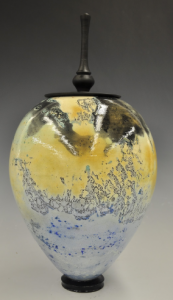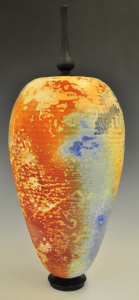Jason Palmer and Professor Brian Christensen, Department of Visual Arts
Overview
The aims and purposes of this ORCA funded research project were two fold; first the funds would be used to renovate a heavily used kiln in the ceramics department to allow for greater atmospheric control, operator’s ease of use, and general safety. Second we would begin an investigation into the underlying forces that caused the characteristic color patterns inherent in the American Sagger process in an attempt to replicate these patterns in a more precise, controllable, and visually appealing way. Our hope was that through using rigorous scientific methods and controlled experimentation we would not only gain an understanding of the chemicals and process responsible for the color production but also replicate and improve upon these patterns. Through a direct chemical understanding of the sagger process we could push the artistic possibilities further than previously possible while providing resources and educational documentation for the continued use by future students and artists.

Outcomes
Overall our experimentations and results have been very successful. All the supplies, design plans, and equipment necessary for the reconstruction of the kiln have been bought and finalized. However, due to an Alternative kiln and Clay Processes class taught last semester and unusually high kiln usage the kiln has not yet been rebuilt. The rebuild will begin next semester as the Alternative Kiln and Clay Processes class is only taught in the fall. Our second objective to better understand the chemical process and increase the artistic possibilities of the sagger processes has made significant progress and is beginning to receive community wide notification. We have successfully been able to identify and isolate the chemicals responsible for the Sagger firing effect and the work produced for this research has been featured in two separate gallery shows while the process received video documentation by an unaffiliated internet blog. On campus many students have professed an interest in this work and we are beginning to teach the process in some of the advanced studio classes.
Methods
In beginning our research we suspected the Sagger colors to be the result of metal salts dissolved in the organic material found within the sagger. Working crossdisciplinary with students and professors from the chemistry and biology departments we have been able to successfully identify and isolate twenty six soluble metal salts present in various sagger firings. Using established chemical synthesis pathways we have been able to synthesize many of these compounds from scratch using metal ore, acids, and organic solvents. The resulting chemicals we then used in subsequent, controlled saggers, successfully reproducing the desired effects with greater clarity and control. Our first efforts in the chemical isolation tests, however, lacked the visual depth and color brightness of the original sagger pieces. Through continued testing and experimentation we discovered that two separate classes of salts are necessary, which are commonly associated in the natural, organic sagger process. We learned that one subset of soluble metal salts (DBlock Salts) was responsible for color production while an entirely different subset (SBlock Fluxing Salts) worked to induce a phase change in the surface of the ceramic ware thus allowing the metal salts to bind and produce colors. By carefully pairing the decomposition temperature of the DBlock salts with the appropriate SBlock salt the chemicals effectiveness and overall appearance were drastically improved.

Continuation
The research into the American sagger process is an ongoing and ever changing thing. It is our hope that we will be able to teach our findings and processes to future students and artists so they may continue to explore and develop this method. The research that has been done through this ORCA grant is currently being compiled into an instructional gallery show that will open on February 3rd in the 303 Gallery here on the BYU campus. We are also currently working with representatives from both The Universe and The Daily Herald newspapers to feature articles about the show. It is our goal to use the media publications in tandem with the BYU gallery showcase to present the show and its associated research for acceptance into the Leonardo Science and Technology Arts Museum in Salt lake City.
References
● http://greyforeststudio.com/2013/11/10/artistspotlightjasonpalmer/
● Stephenson, H H. Ceramic Chemistry. Forgotten Books. Berlin, Germany. 2012.
